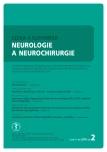Development of Neurological and Functional Clinical Picture after Spinal Cord Injury
Authors:
J. Kříž 1,2; V. Hyšperská 1
Authors‘ workplace:
Spinální jednotka při Klinice RHB a TVL 2. LF UK a FN v Motole
1; Ortopedicko-traumatologická klinika 3. LF UK a FNKV
2
Published in:
Cesk Slov Neurol N 2014; 77/110(2): 186-195
Category:
Original Paper
Poděkování RNDr. Marku Malému, CSc., za pomoc se statistickým zpracováním souboru.
Overview
Aim:
To present neurological and functional outcome in patients one year after spinal cord injury (SCI).
Patients and method:
Patients with traumatic spinal cord lesion hospitalized at the Spinal Cord Unit in Prague from 2006 to 2012 were examined in regular intervals within one year after the injury. A total of 113 patients, 87 males and 26 females were included. Neurological examination according to the International Standards for Neurological Classification of Spinal Cord Injury (ISNCSCI) and functional assessment according to the Spinal Cord Independence Measure (SCIM) was performed.
Results:
Patients after complete lesion (74 patients) had the mean increase in the motor score of 3.45 ± 5.88 points (± SD) and patients after incomplete lesion (39 patients) had the mean increase of 12.41 ± 10.21 points, respectively. The sensory score increased by 7.14 ± 10.07 points in patients with complete and by 8.46 ± 16.23 points in patients with incomplete lesion. The mean increase in SCIM was 41.23 ± 15.15 points in patients with motor complete lesion and by 55.04 ± 26.30 points in patients with motor incomplete lesion. Comparing the 1st and 3rd functional assessment, at least one segment neurological level improvement was found in 48.72% of patients. In 29.73% patients, the initially complete lesion changed to an incomplete lesion (AIS A to AIS B– D), a change from AIS B to AIS C or D was found in 37.5% and a change from AIS C to ASI D in 92.31%.
Conclusion:
We identified a significant improvement in motor and sensory function in individuals one year after spinal cord injury. The neurological level of injury and the extent of injury may thus change with time. Improvement in functional abilities is even more obvious. The results should serve as a guidance for future therapeutic interventions.
Key words:
spinal lesion – neurological classification – functional classification – compensation – recovery
The authors declare they have no potential conflicts of interest concerning drugs, products, or services used in the study.
The Editorial Board declares that the manuscript met the ICMJE “uniform requirements” for biomedical papers.
Sources
1. Van Hedel HJ. Improvement in function after spinal cord injury: the black- box entitled rehabilitation. Swiss Med Wkly 2012; 20(12): 2– 14.
2. Curt A, Schwab ME, Dietz V. Providing the clinical basis for new interventional therapies: refined diagnosis and assessment of recovery after spinal cord injury. Spinal Cord 2004; 42(1): 1– 6.
3. Kirshblum SC, Waring W, Biering– Sorensen F, Burns SP, Johansen M, Schmidt-Read M et al. Reference for the 2011 revision of the International Standards for Neurological Classification of Spinal Cord Injury. J Spinal Cord Med 2011; 34(6): 547– 554.
4. Catz A, Itzkovich M, Tesio L, Biering-Sorensen F, Weeks C, Laramee MT et al. A multicenter international study on the Spinal Cord Independence Measure, version III: Rasch psychometric validation. Spinal Cord 2007; 45(4): 275– 291.
5. Keith RA, Granger CV, Hamilton BB, Sherwin FS. The functional independence measure: a new tool for rehabilitation. Adv Clin Rehabil 1987; 1: 6– 18.
6. Levin MF, Kleim JA, Wolf SL. What do motor “recovery” and “compensation” mean in patients following stroke? Neurorehabil Neural Repair 2009; 23(4): 313– 319.
7. Curt A, Van Hedel HJ, Klaus D, Dietz V; EM– SCI Study Group. Recovery from a spinal cord injury: significance of compensation, neural plasticity, and repair. J Neurotrauma 2008; 25(6): 677– 685.
8. Ditunno JF Jr, Cohen ME, Hauck WW, Jackson AB, Sipski ML. Recovery of upper- extremity strength in complete and incomplete tetraplegia: a multicenter study. Arch Phys Med Rehabil 2000; 81(4): 389– 393.
9. Högel F, Mach O, Maier D. Functional outcome of patients 12 and 48 weeks after acute traumatic tetraplegia and paraplegia: data analysis from 2004– 2009. Spinal Cord 2012; 50(7): 517– 520.
10. Zariffa J, Kramer JL, Fawcett JW, Lammertse DP, Blight AR, Guest J et al. Characterization of neurological recovery following traumatic sensorimotor complete thoracic spinal cord injury. Spinal Cord 2010; 49(3): 463– 471.
11. Steeves JD, Kramer JK, Fawcett JW, Cragg J, Lammertse DP, Blight AR et al. Extent of spontaneous motor recovery after traumatic cervical sensorimotor complete spinal cord injury. Spinal Cord 2011; 49(2): 257– 265.
12. Spiess MR, Müller RM, Rupp R, Schuld C; EM– SCI Study Group, van Hedel HJ. Conversion in ASIA impairment scale during the first year after traumatic spinal cord injury. J Neurotrauma 2009; 26(11): 2027– 2036.
Labels
Paediatric neurology Neurosurgery NeurologyArticle was published in
Czech and Slovak Neurology and Neurosurgery

2014 Issue 2
Most read in this issue
- Autonomic Dysreflexia – a Serious Complication of Spinal Cord Injury
- Dravet Syndrome: Severe Myoclonic Epilepsy in Infancy – Case Reports
- Normative Values of Nerve Conduction Studies of the Ulnar and Median Nerves Measured in a Standardized Way
- Neuromodulation
